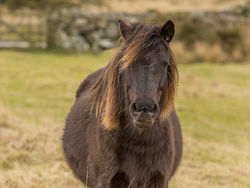
Ponies have been recorded as living on Dartmoor since the Middle Ages. The superb metabolism of the ponies allows them to prosper in the harsh and inhospitable conditions they have to contend with during the winter months. Blessed with an exceptional temperament, their potential as children's ponies and their ability to make wonderful companions, driving ponies and conservation grazers makes them the perfect choice for so many.
The Dartmoor Pony
 |  |  |
|---|---|---|
 |  |  |
 |  |  |
The Breed Standard of the Dartmoor Pony – taken from Dartmoor Pony Society website at www.dartmoorponysociety.com
Height: Not Exceeding 127 cm. (12.2hh.)
Colour: Bay, brown, black, grey, chestnut, roan. Piebalds and Skewbalds are not allowed. Excessive white markings should be discouraged.
Neck & Head: The head should be small with large kindly eyes and small alert ears. It should be well set on a good neck of medium length. The throat and jaws should be fine and showing no signs of coarseness or throatiness. Stallions to have a moderate crest.
Shoulders: Good shoulders are most important. They should be well laid back and sloping, but not too fine at the withers.
Body: Of medium length and strong, well ribbed up with a good depth of girth giving plenty of heart room.
Loin & Hindquarters: Strong and well covered with muscle. The hind quarters should be of medium length and neither level nor steeply sloping. The tail is well set up.
Limbs: The hocks should be well let down with plenty of length from hip to hock, clean cut and with plenty of bone below the hock. They should have a strong second thigh. They should not be 'sickled' or 'cow-hocked'.
The forelegs should not be tied in at the knee. The fore-arm should be muscular and relatively long and the knee fairly large and flat at the front.
The cannons should be short with ample good, flat, flinty bone. The pasterns should be sloping but not too long. The feet should be hard and well-shaped.
Movement: Low and straight coming from the shoulder with good hock action but without exaggeration.
General: The mane and tail should be full and flowing. The Dartmoor is a very good looking riding pony, sturdily built yet with quality.
